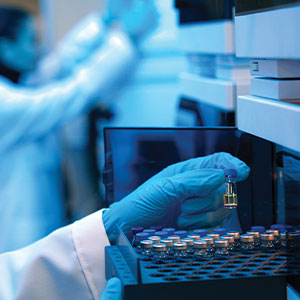Since the explosion of plastic consumption and production starting in the 1950s, billions of tons of plastics have been produced, and microplastics form during the manufacturing, product use, and breakdown of plastics1. Due to microplastics being released during the entire product life cycle, people are exposed to microplastics in our air, food, and water. Awareness of microplastics in water and consideration for the effects are relatively recent issues of importance for those concerned with the environment and sustainability. While little is known about the effects of this waste, many responsible manufacturing companies are choosing to take steps to mitigate and reduce their output of microplastics to minimize the environmental footprint of plastics.
 In industry, the current methods to measure microplastics lack standardization, are highly prone to contamination, and do not measure small enough particles. Nike recently released a case study, “Measuring and Controlling Microparticles in Textile Wastewater” leveraging Particle Measuring Systems’ (PMS) Liquilaz® II particle counter to count microplastics. Authored by John H. Rydzewski, Richard Woodling, and Yue Yang, the paper discusses the goal to minimize microplastics in aquatic systems while validating the results through the LiQuilaz II particle counter. The authors of this paper propose a new approach of measurement and filtration that has the opportunity to reduce the microplastics that end up in our water. This alternative method would allow manufacturers to measure particles in treated textile water continuously for particles that are as small as 2.0 microns2.
In industry, the current methods to measure microplastics lack standardization, are highly prone to contamination, and do not measure small enough particles. Nike recently released a case study, “Measuring and Controlling Microparticles in Textile Wastewater” leveraging Particle Measuring Systems’ (PMS) Liquilaz® II particle counter to count microplastics. Authored by John H. Rydzewski, Richard Woodling, and Yue Yang, the paper discusses the goal to minimize microplastics in aquatic systems while validating the results through the LiQuilaz II particle counter. The authors of this paper propose a new approach of measurement and filtration that has the opportunity to reduce the microplastics that end up in our water. This alternative method would allow manufacturers to measure particles in treated textile water continuously for particles that are as small as 2.0 microns2.
Nike chose to include the Liquilaz II particle counter in their solution because of its proven accuracy in high-tech industries and ability to reliably count to 2.0 micron particles. Helping Nike reduce microplastic pollution aligns well with the values of Particle Measuring Systems. PMS has a Roadmap to Net Zero and is concerned with environmental issues such as clean water. Because of this alignment in values, the PMS team provided support to the Nike team in their case study to help verify and quantify their manufacturing improvements using the Liquilaz II particle counter. The PMS team also provided assistance in outfitting the Liquilaz II particle counter with an integrated SLS-2000 Syringe Sampling System in order to draw in samples from a beaker using a vacuum. The Liquilaz II particle counter is typically a continuous (24/7), online, flow-through particle counter, but the addition of the sampler enabled the authors to use the particle counter in a laboratory setting, taking individual measurements of specified samples. This system of instruments allowed the Nike team to perform this experiment and minimize potential contamination.
 Using these liquid particle counters, Nike collected significant data on microparticles in textile wastewater and made significant conclusions about filtration and particle counting as the future of managing the release of microplastics from textile manufacturing. Rydzewski et. al. were able to demonstrate that the particle counts, total suspended solids (TSS), and total solids (TS) had no correlation, illustrating the need to shift away from mass-based standards of measuring microparticles. This shift would also have the benefit of better aligning with the global discussion of the impact of microparticles: typically talked about in relation to discrete particles rather than a mass of particles. The Nike team also concluded that a membrane bioreactor (MBR) or clarifier in combination with downstream ultrafiltration (UF) would remove almost all the microparticles from textile mill wastewater, preventing their release into the environment. In addition, the LiQuilaz® II particle counter in an inline configuration, post-filtration system would help maintain the membrane and filtration integrity of the system to ensure its continued efficacy.
Using these liquid particle counters, Nike collected significant data on microparticles in textile wastewater and made significant conclusions about filtration and particle counting as the future of managing the release of microplastics from textile manufacturing. Rydzewski et. al. were able to demonstrate that the particle counts, total suspended solids (TSS), and total solids (TS) had no correlation, illustrating the need to shift away from mass-based standards of measuring microparticles. This shift would also have the benefit of better aligning with the global discussion of the impact of microparticles: typically talked about in relation to discrete particles rather than a mass of particles. The Nike team also concluded that a membrane bioreactor (MBR) or clarifier in combination with downstream ultrafiltration (UF) would remove almost all the microparticles from textile mill wastewater, preventing their release into the environment. In addition, the LiQuilaz® II particle counter in an inline configuration, post-filtration system would help maintain the membrane and filtration integrity of the system to ensure its continued efficacy.
1 US Department of Commerce, N. O. and A. A. (2016, April 13). What are Microplastics?. NOAA’s National Ocean Service. https://oceanservice.noaa.gov/facts/microplastics.html#:~:text=Most%20plastics%20in%20the%20ocean,through%20waterways%20into%20the%20ocean.
2 Rydzewski, John & Woodling, Richard & Yang, Y. (2022). Measuring and Controlling Microparticles in Textile Wastewater. 10.13140/RG.2.2.22784.10246.
